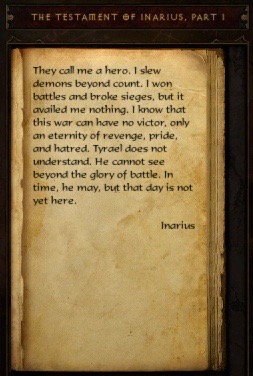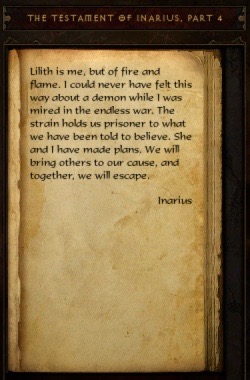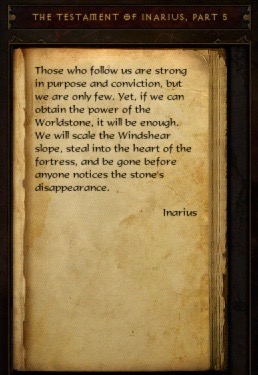
It started with Inarius. According to the Book of Cain, Inarius was an advisor to the Angiris Counsel who served Tyrael, archangel of Justice. After fighting against the demons in countless battles, Inarius began seeing the Eternal Conflict as unjust. He decided to opt-out.
It is easy to see why an angel who spent his time with Tyrael, in The Courts of Justice, would develop a keen sense of what is just and what is unjust. Inarius took what he learned a bit farther than the other angels would, and determined that a never-ending, unwinnable, war could not be considered just.
The Testament of Inarius, Part I, (and all of the other parts) can be found in-game in Act V. It says:

They call me a hero. I slew demons beyond count. I won battles and broke sieges, but it availed me nothing. I know that this war can have no victor, only an eternity of revenge, pride, and hatred. Tyrael does not understand. He cannot see beyond the glory of battle. In time, he may, but that day is not yet here.
This observation made Inarius a renegade angel. His view of The Eternal Conflict no longer matched that of the other angels, and he dared to actively seek a change that would get him out of the endless war.
The Testament of Inarius, Part 2, says:

There must be others who seek a way out of the endless strife. Angels and demons who feel enslaved by our fate. I cannot be unique in all of creation. I know my path: I will find those disillusioned of the war and lead them.
According to the Book of Cain, Inarius ended up either wounded, or marooned, on some broken part of the Pandemonium Fortress. What happened next is a little unclear.
Deckard Cain presumed that Inarius intended to meet Lilith there. However, the journals that drop in Act V of Diablo III tell a different story. Inarius didn’t know it yet, but Lilith had her own reasons for wanted to opt-out of The Eternal Conflict.

The writings of Lilith can also be found in Act V of Diablo III. Part 1 says:
My father is content to fight the same battles and the same foes while everything turns to ashes. Though his victories might last a day, or a year, or a hundred years, the war will never be won so long as he and his brothers lead. There is an end to it, but fools like my father are too blind to see it.
Lilith’s father is Mephisto, Lord of Hatred. The Book of Cain states that Lilith “suffered from the hatred of her father from time immemorial” and had long awaited an opportunity to rebel.
It seems to me that it was only a matter of time before Lilith and Inarius found each other and realized that they shared the same goal.
The Testament of Inarius, Part 3, explains what happened to him after he was injured and/or marooned.

I was struck down in the third charge. I lay upon the ground only to wake in chains. I did not know that demons took prisoners. I babbled like a fool about my dreams of escaping this war. My captor freed me and said that we would meet again. Her name was Lilith, daughter of Mephisto.
The Writings of Lilith, Part 2, tells her side of this part of their story:

I took a prisoner in battle, an angel whose light was dimming. I brought him to my lair for my amusement. But he surprised me. My touch seemed to breathe life into him. He raved like a madman about how he wished to escape the war. Perhaps I have found someone I can use.
From Inarius’s perspective, he and Lilith shared the same goal. They both wanted to get away from The Eternal Conflict.
Inarius would not have been safe discussing that publicly with the other angels, most of whom would have vehemently disagreed with his plan. Just the act of talking about leaving The Eternal Conflict would cause disharmony among the angels.
But here was Lilith, who seemed to understand him. Angels are born seeking harmony. Inarius found that with Lilith. That must have been comforting, considering that he had yet to find any angels who thought like he did.
Demons, however, have no interest in harmony. They are much more inclined to cause chaos. Lilith viewed Inarius as “someone I can use.” She was tired of the Eternal Conflict, but her main goal was to rebel against her father. What better way to get a reaction from him than to side with an angel against the war that Mephisto enjoyed fighting in?
Their story continues in The Testament of Inarius, Part 4:

Lilith is me, but of fire and flame. I could never have felt this way about a demon while I was mired in the endless war. The strain hold us prisoner to what we have been told to believe. She and I have made plans. We will bring others to our cause, and together, we will escape.
This is the point where Inarius realizes that not only must there be other angels – but also other demons – out there who wanted out of the Eternal Conflict. All they had to do was find them. Inarius would seek out the angels, and Lilith would gather up like-minded demons.
And so, they did. The next step was finding some place where all of them could go. It had to be a place that neither the angels nor the demons knew about. Lilith had a plan.
The Writings of Lilith, Part 3 explains it:

The angel I captured, Inarius, is in love with me. I can feel the intensity of his desire. I told him that we must liberate the Worldstone, and then we can be together. We will create something never imagined by those mired in the Eternal Conflict. A new world.
The success or failure of their plan depended entirely upon whether or not they could obtain the Worldstone. The Book of Tyrael explains that it was a highly sought after item by both The High Heavens and The Burning Hells. Each side wants complete control of the Worldstone because it the artifact would give them the to power to shape worlds in their own image.
The ownership of the worldstone changed hands innumerable times over the eons of battle. Neither side is able to keep it for long. The Eternal Conflict often took place in Pandemonium Fortress, where the Worldstone was kept.
The Book of Cain explains the Worldstone this way: The war was most commonly fought within the realm of Pandemonium. Accordng to one of the earliest necromancers, the angels and the demons battled over control of one essential object, the Heart of Creation – the Worldstone.
The Worldstone is not, as the name implies, a mere stone. It is a colossal, mountain-sized object which was believed by many (and is supported by multiple petroglyphs and ancient sculptures) to be the actual Eye of Anu, the One. According to legend, to which I subscribe, the Worldstone is an artifact of unimaginable power.
The Testament of Inarius, Part 5, gives a glimpse into how Inarius managed to steal the Worldstone:

Those who follow us are strong in purpose and conviction, but we are only few. Yet, if we can obtain the power of the Worldstone, it will be enough. We will scale the Windshear slope, steal into the heart of the fortress, and be gone before anyone notices the stone’s disappearance.
It wasn’t immediately clear to the angels and the demons exactly how Inarius managed to steal the Worldstone. The Book of Tyrael says: Inarius then altered the frequency of the Worldstone, thrusting the crystal into a parallel reality and shrouding it from the eyes of the Heavens and the Hells. There, the renegade angels and demons created Sanctuary, a wondrous paradise world where they could spend eternity in peace.
It should be noted that at the time Inarius stole the Worldstone, none of the angels, or the demons, understood what Inarius was up to. For a while, all they knew was that the Worldstone was missing. Tyrael wrote about it long after everything got sorted out.
According to the Book of Cain, the Eternal Conflict came to a “grinding halt” over the Worldstone’s disappearance. Deckard Cain, of course, wrote this long after the event happened. He found it funny.
Deckard Cain wrote: For my own part, it is amusing to think of what it must be like for the forces of Heaven and Hell to fight their way to the Worldstone’s usual location, only to find it missing. I would speculate that for a time both groups must have accused the other of stealing it, until they were finally convinced that their opponents were just as confused as they were.
The Testament of Inarius Part 6 explains what Inarius was thinking after stealing the Worldstone:

Can I truly love a demon? When I gave the Worldstone to Lilith, I knew that I had been right to seek her all along. We have created a new world. We can live here in peace, away from war. I have named this world Sanctuary.
The Writings of Lilith, Part 4, show that Lilith saw things differently than Inarius did:

Inarius and I stole the Worldstone, and now we have a group of renegades to follow us. I have created a new world where we can live in peace. A place of infinite possibilities. Inarius believes that escape is enough. In time, I will show him that even victory is possible. But first, I will give him children.
Inarius sees Sanctuary as the end-goal. Lilith sees it as a starting point. Inarius views what happened as: “We created a new world”. Lilith sees it as “I created a new world.”
She sees the renegades as people whom she can rule over. Inarius probably viewed them as equals. Lilith knew that Inarius was in love with her. She never said that she was in love with Inarius.
It was only a matter of time before their place of peace turned violent.
But before that happened, Inarius created Mount Arreat around the Worldstone. It would serve as a protective shell for the powerful artifact. The rest of Sanctuary was formed after that.
Lore of the Creation of Sanctuary is a post written by Jen Thorpe on Book of Jen and is not allowed to be copied to other sites.
If you enjoyed this blog post please consider supporting me on Ko-fi. Thank you!

Love this! Thank you!! It actually filled in some blanks and answered some questions that I had.
Awesome! I didn’t realize how much lore I didn’t put together throughout the series.
Nice work Jen. Inspiring as well, as I also am plague with chronic illness
PS: Now I know for sure that Lilith is my ex 😂